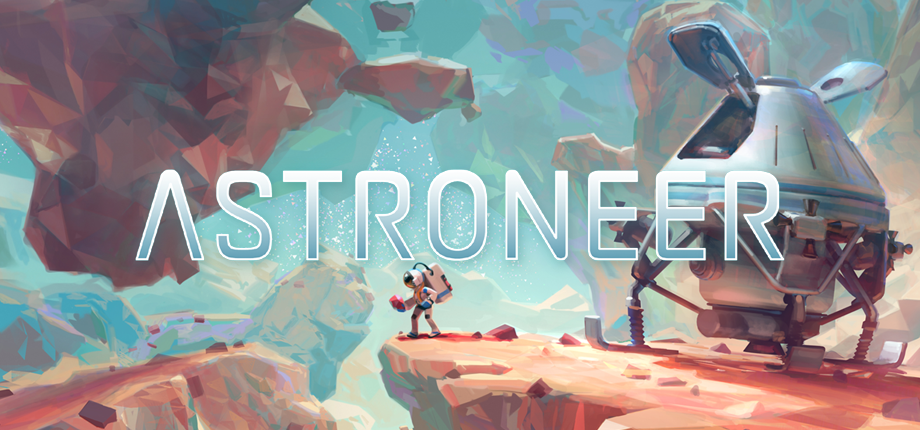Does the thought of Space exploration and Minecraft pique your interest? Then read on to discover what adventures await in the world of Astroneer.
Type: Single-player
Genre: Adventure
Developer: System Era Softworks
Publisher: System Era Softworks
Release Date: Feb 6, 2019


Explore and reshape distant worlds! Astroneer is set during the 25th century’s Intergalactic Age of Discovery, where Astroneers explore the frontiers of outer space, risking their lives in harsh environments to unearth rare discoveries and unlock the mysteries of the universe.
On this adventure, players can work together to build custom bases above or below ground, create vehicles to explore a vast solar system, and use terrain to create anything they can imagine. A player’s creativity and ingenuity are the keys to seeking out and thriving while on exciting planetary adventures!
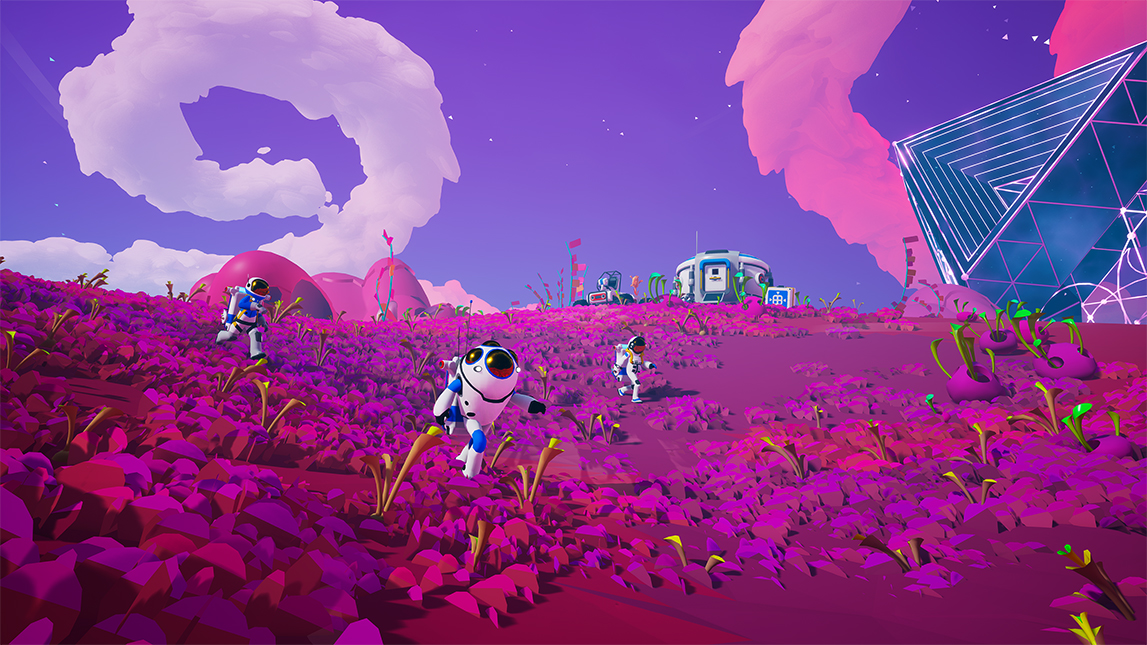
Introduction
System Era Softworks are the folks behind Astroneer. Based in Seattle, Washington in the good old US of A. The team is comprised of veteran developers who have worked previously for 343 Industries, Disney, EA, Valve, and Ubisoft. The project was formally announced way back in October 2015 and given a Steam early access release in December 2016. Since then, numerous builds have been created which have added many new gameplay elements and systems. February is upon us and the 1.0 release is here with a huge jump in new features including a total refresh of the terrain code, adding extra layers to the cave systems and much more.
Content
If you have ever played Minecraft or the likes of Subnautica, then you will know the drill and basic synopsis of these kinds of games. It’s man versus the environment. Whether it be oceanic, fantasy or based on a near future science premise, Astroneer doesn’t deviate from the genre fundamentals. It is a tried and trusted formula that is both addictive and engaging.
There’s no deep back story or narrative to accompany the discovery and crafting style of the game. The opening menu gives you the option to try out the tutorial planet or go for the full-blown “campaign”. The latter starts with your single pod blasting off from an orbiting space station and setting down on a procedurally generated planet.
Once you splashdown on Sylva ( one of seven planets in the game’s release build), your dropship auto unloads an exo-habitat and a landing pad. Your space house is a safe haven for when storms arise and for saving your progress. The landing pad delivers you a couple of start-up packages which include a platform and a medium 3D printer. Combining these together gets you off and running. You now have the ability to create a number of extra modules. As with all these types of games, there is a research tree which can unlock more advanced vehicles, gizmos, and doodads.
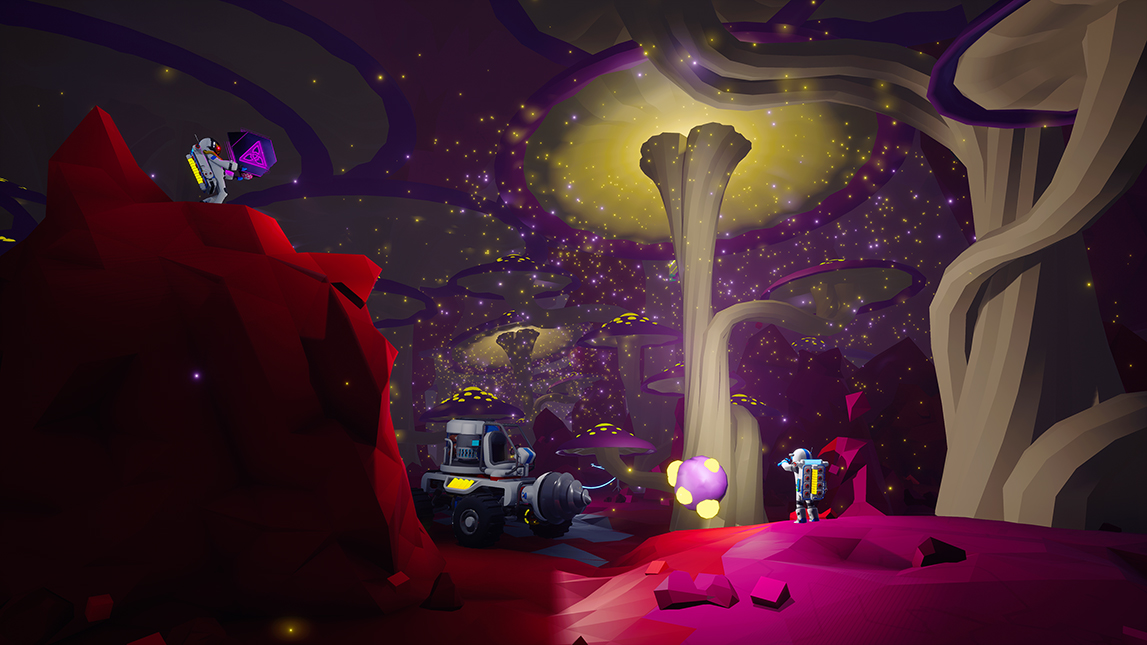
By scanning alien artifacts and crystal nodes scattered across the landscape you collect research bytes. These points can then be spent on unlocking new schematics and blueprints. Scanning nodes that appear on plants and rock nodules gain a few bytes. Much larger samples have to be analysed using the research lab. These yield a lot more data but take time and power to uncover their secrets.
In order to feed these printers and modules, you need to collect resources. To help you with this task, you are equipped with what looks like a funky sci-fi leaf blower. This handy dandy piece of kit allows you to “hoover” up native plant life, soil and even rocks. It can suck up the very fabric of the planet and allow you to dig into the actual strata. Strip mining has never been so much fun. It has three modes of operation once equipped with a canister. It can suck, create, and level the landscape. Further mods up the tech tree give it even more power. The deformation of the terrain is a joy to behold and reminds me of the tech that was used in one of the early Red Faction games. This is GeoMod on steroids.
Apart from collecting resources, you have to keep your astroneer fit and healthy. He/she needs air and power to keep alive. To begin with, this is connected to their spacesuit via a blue umbilical line from the habitat. The kicker is, that this only has a limited range, beyond this, the suit uses its small reserve tank and battery. Depleting your air results in death and a respawn back at the space house sans any of the items you have collected in your backpack. To progress further you can create tethers which extend the blue air cable and are supported by poles. Not only do these act as a lifeline, but they also function as navigation signposts. It is a genius design move, so simple, so efficient and completely believable in scientific terms. If you have ever seen any documentaries on cave divers you will be very familiar with this tech already.
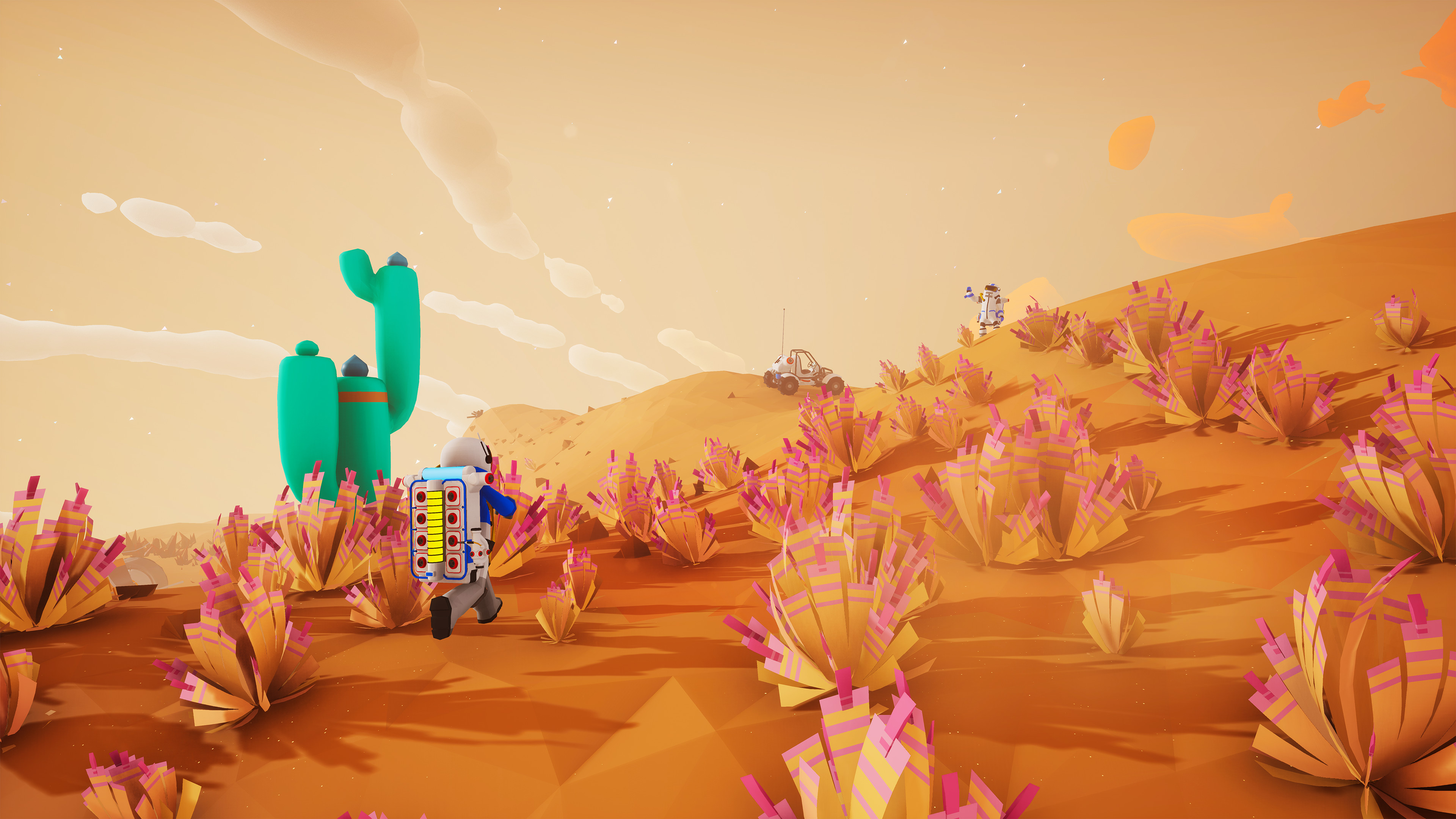
Real science plays a great part in the whole fabric of the world. Knowledge of ore deposits true naming conventions will give you a leg up when searching for specific metals. My lacking understanding of the basic elements was helped greatly by the tooltips which highlight what can be obtained from smelting particular compound / mineral-laden rocks. This science-based learning through entertainment is a key pillar of the design. It’s not done in a forced or preachy manner, just via gentle guidance with every module showing a clear shopping list of ingredients.
In the alpha build, the only hazard above ground you have to contend with was the occasion dust storm which ranged in ferocity. If nearby you could shelter in the exo-habitat and wait out the maelstrom. Caught out in the open your only option was to seek respite underground in one of the many caves dotted about the landscape. If that wasn’t possible then you had to prepare for the worst as the winds hurtled boulders and rocks with wild abandon. This is not the case on the new starting planet Sylva, which has a far more benign weather system. I guess this was tweaked to ease new players into the game, without the bothersome storms disrupting their building progression.
Venturing further into the bowels of the planet you will encounter some weird life forms/plants. Stray too close and some can expel green toxic clouds which kill you unless you make a quick getaway. There are other plants which explode when you venture near them along with a couple of more deadly flora type,s but I’ll not spoil the “fun” if you happen upon them.
The cavern systems are vast and labyrinthian. As you explore the deeper sections rare minerals can be found. Extracting them safely can take several visits, setting up tethers and creating pathways using the terrain tool. Soon you will have a logistics network than even DHL would be proud of.
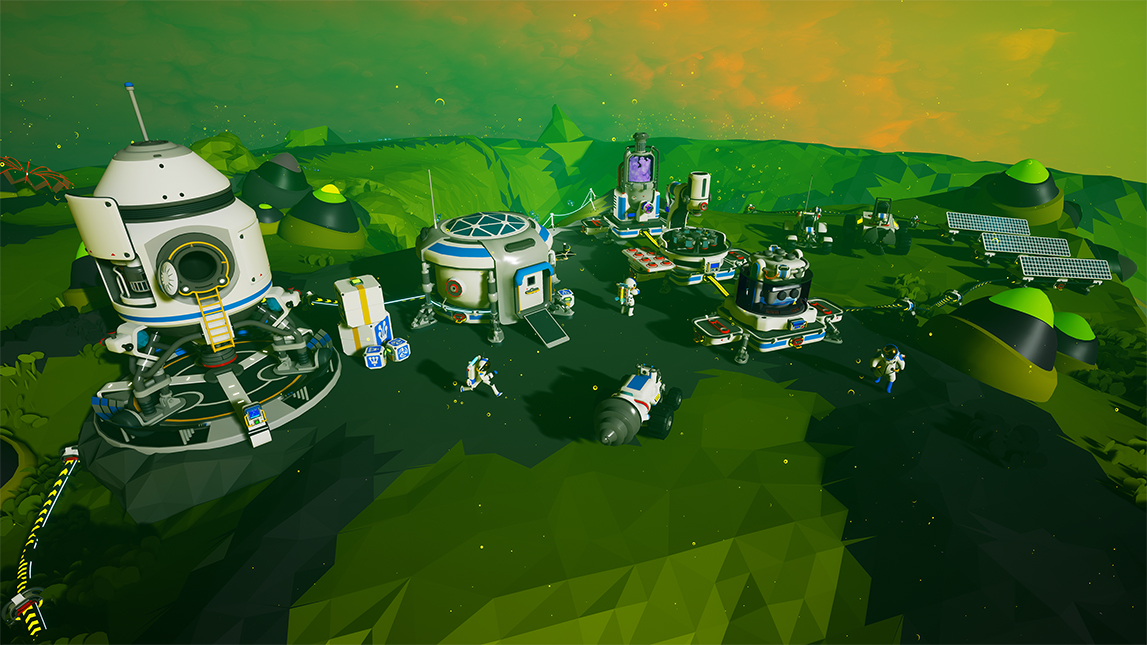
Once harvested and returned to your base of operations. Resources can be processed into useful items such as ingots. These other elements can be further refined using modules such as centrifuges and chemical labs. Now replete with a larder of useful items, you can build vehicles and a whole host of devices to make life a bit more manageable on this hostile and unforgiving planet. Creating your first scout buggy is immensely satisfying. Bouncing around the landscape due to the simulated low gravity conjures images of the famous Apollo moon missions. I can almost hear the classic “Yahoo” sample clip as you hurtle along the rugged terrain.
Scattered around the environment you can discover the shattered remains of failed missions. These can range from stricken vehicles, dilapidated habitats and even massive space stations. Useable modules can be found if you are lucky and really give you a boost up the tech tree, especially if you are lacking in some fundamental resources to craft them yourself. Other scrap parts can be reprocessed but this requires high-level equipment which I have not unlocked yet.
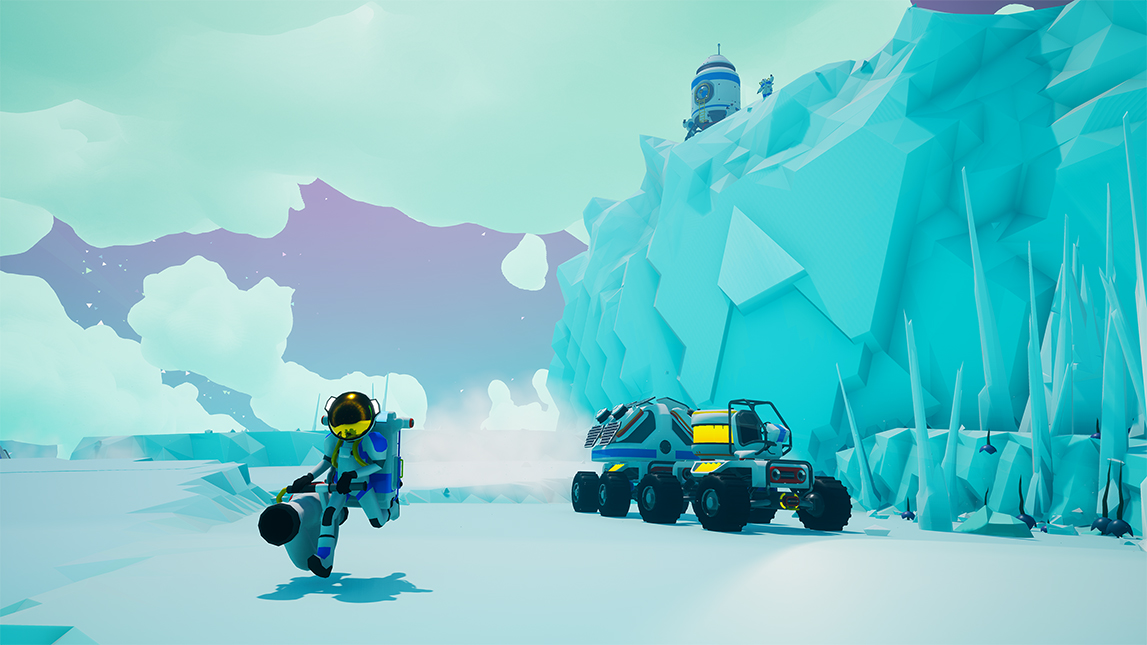
Adding a further layer of realism is the day/night cycle. This is presented by a totally authentic skybox. Lesser devs might have just used a collection of stock images and used a simple fade technique to portray a 24-hour cycle. This not the case here. All the planets in the local group are rendered and displayed accurately. So every day the sky is constantly changing as your host planets draw near to other exotic worlds.
The passing of time also has an impact on energy generation. By constructed solar panels you can power up not only your suit but other equipment that requires electricity. I found out the hard way when I got stranded whilst on maneuvers with my solar powered buggy, I forgot about the impending darkness and ran my battery down. This left me with no choice but to hunker down till dawn so I could juice up and return to base.
As the days’ progressed and my living standards increased, I took a moment to gaze in wonder at the other orbiting planetoids in the sky. These far off rocks look totally different that Sylva, the place I have called home for so long. Exotic coloured and with strange geological features. I dreamed that one day I could visit these new worlds and explore their secrets. Casually looking at the tech tree I found to my surprise that you can actually undertake such a task. By crafting a small shuttle you can boldly go where no man has been before. Awesome.
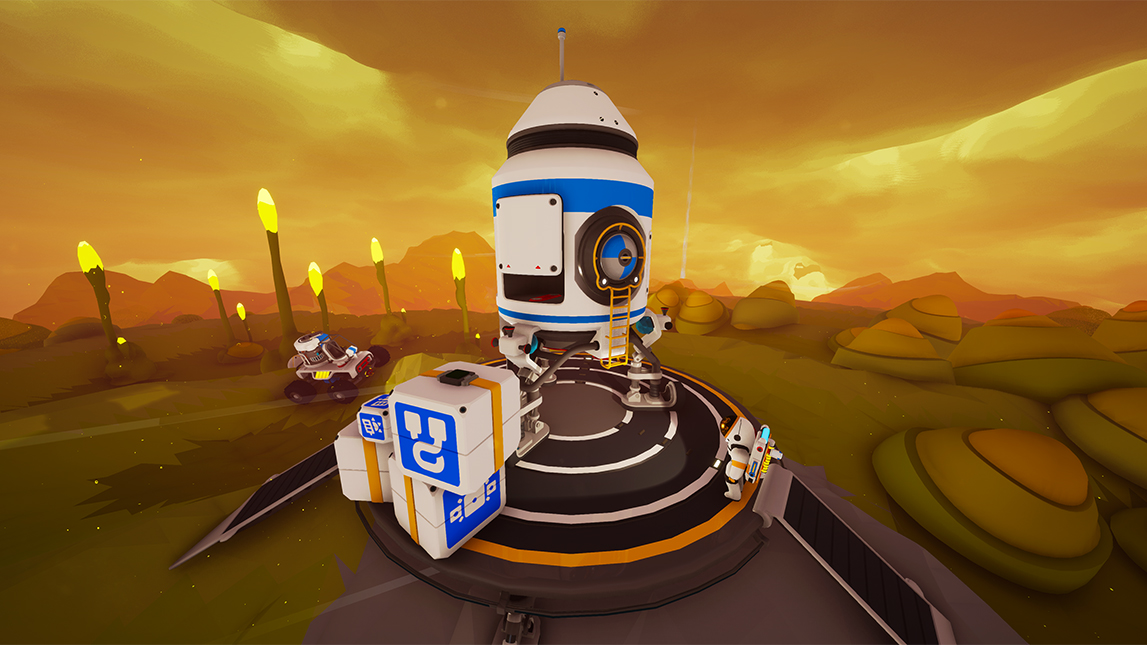
Graphics
Astroneer utilises Unreal Engine 4. My previous experiences with this engine have mixed from spotty performance and beefy system requirements. I’m happy and surprised to report this is not the case with this title. Whether its down to Epic’s continuous updates or the skill of System Era or maybe, a combination of both. The game runs well apart from a couple of minor niggles.
The devs have gone for a low poly aesthetic which fits the genre flawlessly. Graphically it reminds me of Spore and a recent indie title I reviewed called Solo. A bright vibrant palette has been used to give the landscapes a cheery cartoony look. The player model, structures and gizmos all have a classic Lego feel to them. This understated design is both functional and pleasing to the eye. Anybody, even if they aren’t an astrophysicist or science bod will be able to comprehend what a module’s function is and how it fits into the whole scheme of things.
This unfuzzy design ethic permeates throughout the experience. Visual clues tell the player exactly how much energy a battery cell has by simply looking at the yellow charge bars. Additionally, items such as wind turbine blades rotate according to the wind strength. These little details which may seem nondescript, but all add up to deliver a tactile and believable world.
Sound
The soundtrack for crafting games is a hard balancing act. The audio accompaniment has to be engaging yet discreet. An overbearing or limited OST would have me reaching for the mute button. Rutger Zuydervelt, AKA Machinefabriek has hit the sweet spot. His combination of low ambient drones, analog noodlings, and lowercase field recording fit the aesthetic like a glove. If you’re a fan of early Boards of Canada, Neu, Brian Eno and C418 you’ll find lots to enjoy here. The loneliness of space and isolation is captured perfectly with fragile melodies and synth washes. The silence between notes makes them more impactful. Less is more. After numerous hours the top lines and lyrical notes seep into your subconscious. Magic occurs when a half-remembered refrain hits as you climb a bluff and survey the new landscape. Graphics, gameplay, and audio in perfect sync. Bliss.
1.0 Release
The decision to delay the 1.0 release has been justified in my eyes. The difference in both quality, polish, and content between this build and the alpha is remarkable. The GUI has been transformed from a bare-bones presentation to a rather comprehensive suite of options. This includes various graphical sliders, custom key binds, and even a choice of spacesuits.
The terrain 2.0 technology has been rolled out to all the planets. This is evident in the density of plant life on the starting planet Sylva. Forests, grassy prairies, and snowy mountains add variety to the biomes. Underground, the cave system has been tweaked. The basic algorithm for forming the caves has been upgraded. Caves have a more organic cathedral-like appearance. Stalagmites, stalactite formations, and mushrooms clusters complete the authentic atmosphere.
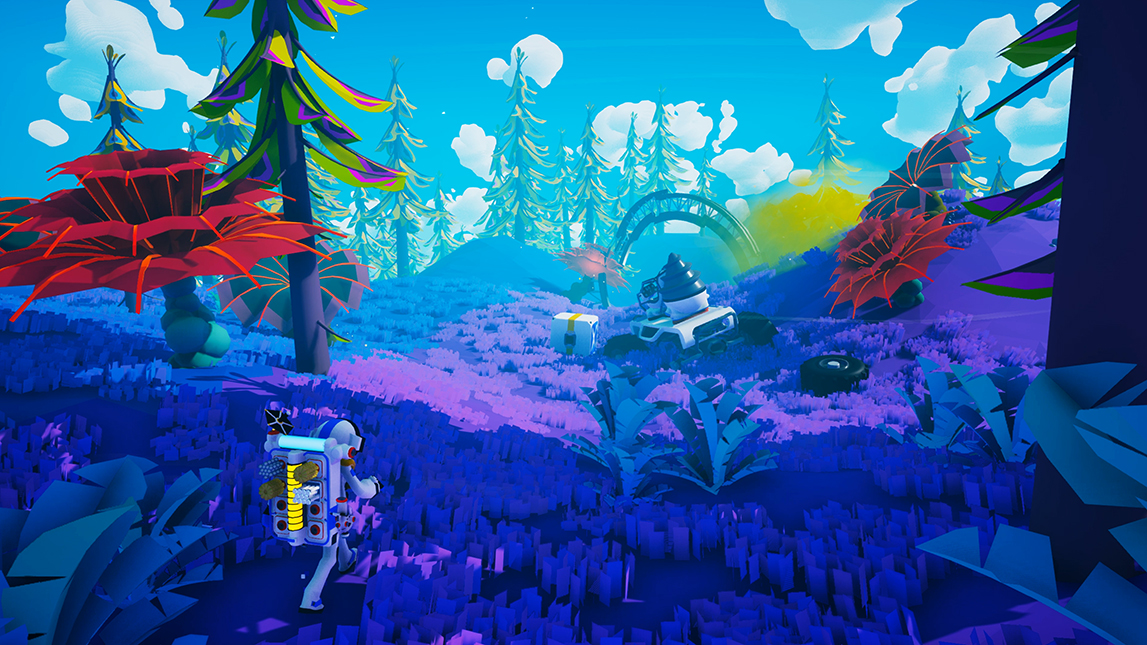
Conclusion
Astroneer hasn’t reinvented the wheel when it comes to the survival/crafting genre. It’s definitely an evolution not a revolution on the beloved Minecraft concept. What it has accomplished is an outstandingly addictive core gameplay loop. All the tech tree trappings are here and executed with verve and style. The aesthetic is clean and bright. The soundtrack understated yet evocative. Its obvious from the care and attention to small details that System Era has a profound passion for space exploration and basic science fundamentals. All these facets have been combined into a deeply compelling title. If the thought of Andy Weir’s novel, “The Martian” brought to life excites you, then Astroneer is well worth a look.

